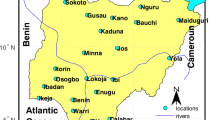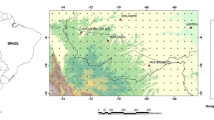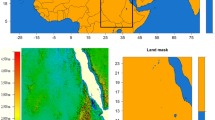Abstract
The study of climatic variables in large scales with surface meteorological stations is limited due to the low density of these stations in many regions, possible sources of errors related to missing data, and uncertainties about the calibration sensors. Global gridded data (GD) systems can minimize these problems. Thus, studies that validate GDs with “ground truth” are important for several applications such as climate change. The objective of this study was to compare long series of surface data with 10-day estimates of average air temperature (T) and precipitation (P) using data from the European Center for Medium-Range Weather Forecast (ECMWF) and the National Aeronautics and Space Administration (NASA) for important agricultural locations in the states of Minas Gerais and São Paulo in Brazil. Despite the different spatial resolutions between ECMWF and NASA, the purpose of this paper was to evaluate the two data sources as they are readily available. The GD performance was evaluated by linear regression analysis. Analyses were performed for each meteorological variable for entire years and separated by seasons. The estimates of T from both ECMWF and NASA systems were accurate with the minimum Willmott concordance index (d) and RMSEp of 0.86, 0.37 °C, respectively, and precision with R2 0.61. The estimates of P had a minimum R2, d, and RMSEp of 0.48, 0.79, 2.15 °C respectively. The decreasing orders of (R2) were autumn > winter > spring > summer for T and winter > autumn > spring > summer for P, varying from 0.93 to 0.61 for T and from 0.77 to 0.48 for P.







Similar content being viewed by others
References
Albergel C, De Rosnay P, Balsamo G, Isaksen L, Muñoz Sabater J (2012) Soil moisture analyses at ECMWF: evaluation using global ground-based in-situ observations. J Hydrometeorol 13:1442–1460
Bai J, Chen X, Dobermman A, Yang H, Cassman KG, Zhang F (2010) Evaluation of NASA satellite- and model-derived weather data for simulation of maize yield potential in China. Agron J 102(1):9–16
Bechtold P, Kohler M, Jung T, Doblas-Reyes F, Rodwell MJ, Viart F, Balsamo G (2008) Advances in simulating atmospheric variability with the ECMWF model: from synoptic to decendal time-scales. Q.J.R. Meteorol Soc 134:1337–1351
Chandler WS, Hoell JM, Westberg D, Whitlock CH, Zhang T, Stackhouse JR PW (2010) Near real-time global radiation and meteorology web services available from NASA. (retrieved on 08.01.2016) <http://www.ases.org/papers/ 120.pdf>
Che T, Dai L, Zheng X, Li X, Zhao K (2016) Estimation of snow depth from passive microwave brightness temperature data in forest regions of northeast China. Remote Sens Environ 183:334–349
Couto FT, Salgado R, Costa MJ, Prior V (2015) Precipitation in the Madeira Island over a 10-year period and the meridional water vapour transport during the winter seasons. Int J Climatol 35:3748–3759
Davey CA, Pielke RASR (2005) Microclimate exposures of surface-based weather stations–implications for the assessment of long-term temperature trends. Bull Am Meteorol Soc 86:497–504
ECMWF (2015) European Centre for Medium-Range Weather Forecasts, www.ecmwf.int. Cited 5 October 2016
Felayi EO, Rabiu AB, Teliat RO (2011) Correlations to estimate monthly mean of daily diffuse solar radiation in some selected cities in Nigeria. Adv Appl Sci Res 2(4):480–490
Gaspar NA, Aparecido LEO, Rolim GS, Souza PS, Botelhos TG (2015) Software for the management of weather stations and for agrometeorological calculations. Aust J Crop Sci 9(6)
Gujarati DN, Porter DC (2011) Econometria Básica 5 ed Bookman: Porto Alegre
Holmes TRH, Jackson TJ, Reichle RH, Basara JB (2012) An assessment of surface soil temperature products from numerical weather prediction models using ground-based measurements. Water Resour Res 48:W02531. https://doi.org/10.1029/2011WR010538
Huffman GJ, Morrissey M, Bolvin DT, Curtis S, Joyce R, Mcgavock B, Susskind J (2001) Global precipitation at one degree daily resolution from multisatellite observations. J Hydrometeorol 2:36–50
IBGE (2016) Instituto Brasileiro de Geografia e Estatística. Disponível em: http://www.sidra.ibge.gov.br/. Acess in 06 oct. 2016
INMET (2016) Instituto Nacional de Meteorologia. Normais climatológicas do Brasil 1961-1990. Disponível em: http://www.inmet.gov.br/portal/index.php?r=clima/normaisclimatologicas Acess in 3 abr. 2016
Johann JA, Rocha JV, Rolim GS, Lamparelli RAC, Duft DG (2011) Comparação entre dados de temperatura média de estações meteorológicas com dados do modelo ECMWF entre 2000 e 2009 no Estado do Paraná. Anais XV Simpósio Brasileiro de Sensoriamento Remoto - SBSR, Curitiba, PR, Brasil, INPE p5817
Kishore P, Jyothi S, Basha G, Rao SVB, Rajeevan M, Velicogna I (2016) Precipitation climatology over India: validation with observations and reanalysis datasets and spatial trends. Clim Dyn 46(1):541–556. https://doi.org/10.1007/s00382-015-2597-y
Kumar P, Kishtawal CM, Pal PK (2017) Impact of ECMWF, NCEP, and NCMRWF global model analysis on the WRF model forecast over Indian Region. Theoretical Appl Climatology 127:143–151. https://doi.org/10.1007/s00704-015-1629-1
Lim HS, Ho CH (2000) Comparison of tropical rainfall between the observed GPCP data and the assimilation products of ECMWF, NCEP/NCAR, and NASA-GEOS-1. J Meteor Soc Japan 78:661–672
Lorenz C, Kunstmann H (2012) The hydrological cycle in three state-of-the-Art reanalyses: intercomparison and performance analysis. J Hydrometeorol 13:1397–1420
Mahmood R, Foster SA, Logan D (2006) The GeoProfile metadata, exposure of instruments, and measurement bias in climatic record revisited. Int J Climatol 26:1091–1124
Mcphee J, Margulis SA (2005) Validation and error characterization of the GPCP-1DD precipitation product over the contiguous United States. J Hydrometeorol 6:441–459. https://doi.org/10.1175/JHM429.1
Moeletsi ME, Walker S (2012) Evaluation of NASA satellite and modelled temperature data for simulating maize water requirement satisfaction index in the Free State Province of South Africa. Phys Chem Earth A/B/C 50-52:157–164 https://doi.org/10.1016/j.pce.2012.08.012
Moraes RA, Rocha JV, Lamparelli RAC (2014) Determination of total accumulated rainfall, global radiation, evapotranspiration and degree-days originated from the ECMWF model to sugar cane crop. Eng Agríc Jaboticabal 34(2):322–331
NASA (2007) NASA surface meteorology and solar energy: methodology. (last viewed 08.05.2016) <http://www.ceoe.udel.edu/windpower/ResourceMap/ SSE_Methodology.pdf>
Pereira AR, Angelocci LR, Sentelhas PC (2002) Agrometeorologia: fundamentos e aplicações práticas. Agropecuária, Guaíba, 478p
Pinker RT, Laszlo I (1992) Modeling surface solar irradiance for satellite applications on a global scale. J Appl Meteorol 31:194–211
Rahman H, Sengupta D (2007) Preliminary comparison of daily rainfall from satellites and Indian gauge data. CAOS Technical report n. 2007 AS1
Ren GY, Chu ZY, Chen ZH, Ren YY (2007) Implications of temporal change in urban heat island intensity observed at Beijing and Wuhan stations. Geophys Res Lett 34:L05711
Rubel F, Rudolf B (2001) Global daily precipitation estimates proved over the European Alps. Meteorol. Z., N.F 10:403–414
Stackhouse P (2006) Prediction of worldwide energy resources. http://power.larc.nasa.gov (verified March 24,2008)
Thornthwaite CW (1948) Na approach toward a rational classification of climate. Geogr Rev 38:55–94
Verkade JS, Brown J, Reggiani P, Weerts AH (2013) Post-processing ECMWF precipitation and temperature ensemble reforecasts for operational hydrologic forecasting at various spatial scales. J Hydrol 501:73–91. https://doi.org/10.1016/j.jhydrol.2013.07.039
Wang X, Song L, Cao Y (2012) Analysis of the weighted mean temperature of China based on sounding and ECMWF reanalysis data. Acta Metall Sin 26(5):642–652
Westberg D, Soja A, Stackhouse JRPW (2010) Linking satellite-derived fire counts to satellite-derived weather data in fire prediction models to forecast extreme fires in Siberia. Geophys Res Abstr 12:EGU2010–EGU5597
White JF, Hoogenboom G, Stackhouse JRPW, Hoell JM (2008) Evaluation of NASA satellite- and assimilation model-derived long-term daily temperature data over the continental US. Agric For Meteorol 148:1574–1584
Willmott CJ (1981) On the validation of models. Phys Geogr 2:184–194
Wu H, Hubbard KG, You J (2005) Some concerns when using data from the Cooperative Weather Station Networks: a Nebraska case study. J Atmos Ocean Technol 22:592–602
Zhou LM, Dickinson RE, Tian YH, Fang JY, Li QX, Kaufmann RK, Tucker CJ, Myneni RB (2004) Evidence for a significant urbanization effect on climate in China. Proc Natl Acad Sci U S A 101:9540–9544
Acknowledgements
This research was supported by the Coordination of Improvement of Higher Level Personnel.
Author information
Authors and Affiliations
Corresponding author
Additional information
Publisher’s Note
Springer Nature remains neutral with regard to jurisdictional claims in published maps and institutional affiliations.
Electronic supplementary material
ESM 1
(DOCX 170 kb)
Rights and permissions
About this article
Cite this article
Valeriano, T.T.B., de Souza Rolim, G., Bispo, R.C. et al. Evaluation of air temperature and rainfall from ECMWF and NASA gridded data for southeastern Brazil. Theor Appl Climatol 137, 1925–1938 (2019). https://doi.org/10.1007/s00704-018-2706-z
Received:
Accepted:
Published:
Issue Date:
DOI: https://doi.org/10.1007/s00704-018-2706-z




